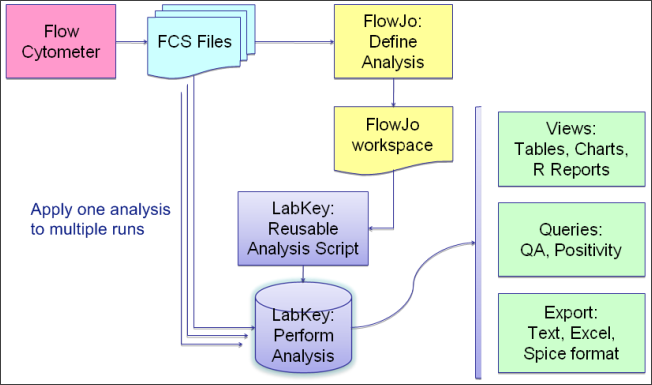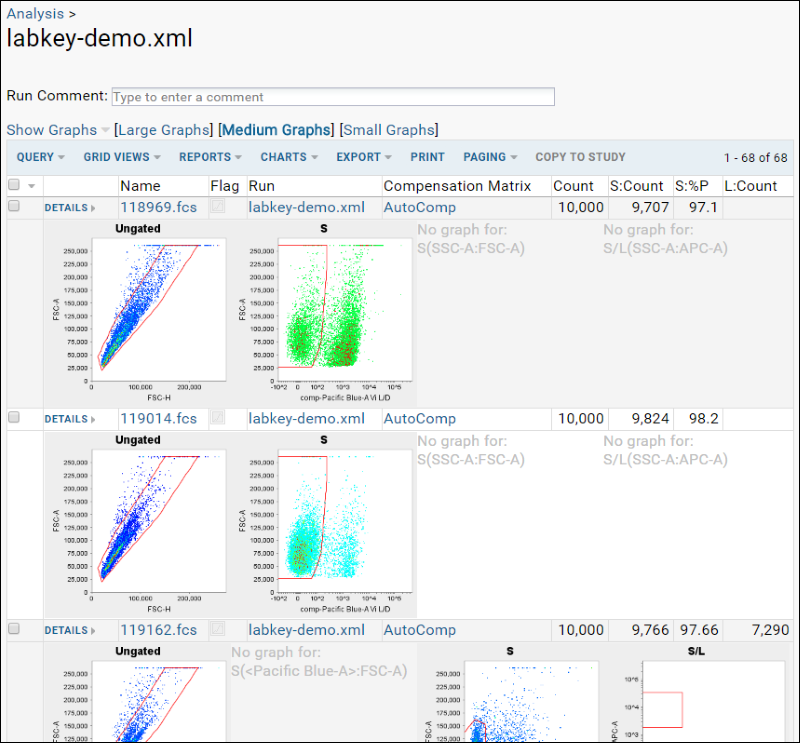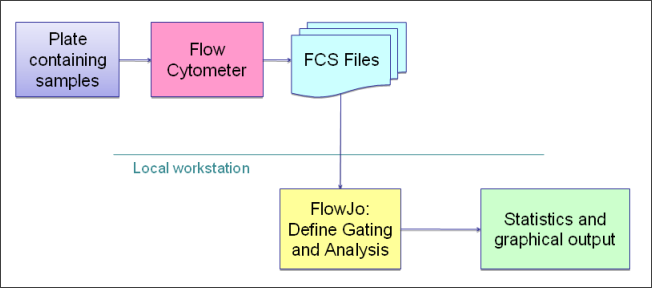Introduction
LabKey Server enables high-throughput analysis for several types of assays, including flow cytometry assays. LabKey’s flow cytometry solution provides a high-throughput pipeline for processing flow data. In addition, it delivers a flexible repository for data, analyses and results. This page reviews the FlowJo-only approach for analyzing smaller quantities of flow data, then explains the two ways LabKey Server can help your team manage larger volumes of data. It also covers LabKey Server’s latest enhancement (tracking of background well information) and future enhancements to the LabKey Flow toolkit.
Background: Challenges of Using FlowJo Alone
Basic ProcessTraditionally, analysis of flow cytometry data begins with the download of FCS files from a flow cytometer. Once these files are saved to a network share, a technician loads the FCS files into a new FlowJo workspace, draws a gating hierarchy and adds statistics. The product of this work is a set of graphs and statistics used for further downstream analysis. This process continues for multiple plates. When analysis of the next plate of samples is complete, the technician loads the new set of FCS files into the same workspace.
ChallengesModerate volumes of data can be analyzed successfully using FlowJo alone; however, scaling up can prove challenging. As more samples are added to the workspace, the analysis process described above becomes quite slow. Saving separate sets of sample runs into separate workspaces does not provide a good solution because it is difficult to manage the same analysis across multiple workspaces. Additionally, looking at graphs and statistics for all the samples becomes increasingly difficult as more samples are added.
Solutions: Using LabKey Server to Scale Up
LabKey Server can help you scale up your data analysis process in two ways: by streamlining data processing or by serving as a flexible data repository. When your data are relatively homogeneous, you can use your LabKey Server to apply an analysis script generated by FlowJo to multiple runs. When your data are too heterogeneous for analysis by a single script, you can use your Labkey Server as a flexible data repository for large numbers of analyses generated by FlowJo workspaces. Both of these options help you speed up and consolidate your work.
Option 1. Apply One Analysis Script to Multiple Runs within LabKey.
LabKey can apply the analysis defined by the FlowJo workspace to multiple sample runs. The appropriate gating hierarchy and statistics are defined once within FlowJo, then imported into LabKey as an Analysis Script. Once created, the Analysis Script can be applied to multiple runs of samples and generate all statistics and graphs for all runs at one time. These graphs and statistics are saved into the LabKey Server’s database, where they can be used in tables, charts and other reports. Within LabKey, flow data can be analyzed or visualized in R. In addition, advanced users can write SQL queries to perform downstream analysis (such as determining positivity). These tables and queries can be exported to formats (e.g., CSV, Excel or Spice) that can be used for documentation or further analysis.
Figure 1: Application of an analysis script to multiple runs within LabKey Server Figure 2: A LabKey run with statistics & graphs
Figure 2: A LabKey run with statistics & graphs Option 2. Use LabKey as a Data Repository for FlowJo Analyses
Option 2. Use LabKey as a Data Repository for FlowJo AnalysesLabKey’s tools for high-throughput flow analysis work well for large amounts of data that can use the same gating hierarchy. Unfortunately, not all flow cytometry data is so regular. Often, gates need to be tweaked for each run or for each individual. In addition, there is usually quite a bit of analysis performed using FlowJo that just needs to be imported, not re-analyzed.
To overcome these obstacles, LabKey can also act as a repository for flow data. In this case, analysis is performed by FlowJo and the results are uploaded into the LabKey data store. The statistics calculated by FlowJo are read upon import from the workspace. Graphs are generated for each sample and saved into the database. Technicians can make minor edits to gates through the LabKey online gate editor as needed.
Figure 4: LabKey Server as a data repository for FlowJo
LabKey Interface: The Flow Dashboard
Both of the options described above can be accessed through a single interface, the LabKey Flow Dashboard. You can use LabKey Server exclusively as a data repository (Option 2 above) and “Import results directly from a FlowJo workspace.” Alternatively, you can “Create an Analysis Script from a FlowJo workspace” and apply one analysis script to multiple runs (Option 1 above).
Figure 5: LabKey Server Flow Dashboard
Annotation Using Metadata
Extra information can be linked to the run after the run has been imported via either LabKey Flow or FlowJo. Sample information uploaded from an Excel spreadsheet can also be joined to the well. Background wells can then be used to subtract background values from sample wells. Information on background wells is supplied through metadata.
Figure 6: Sample and run metadata
 Figure 2: A LabKey run with statistics & graphs
Figure 2: A LabKey run with statistics & graphs
